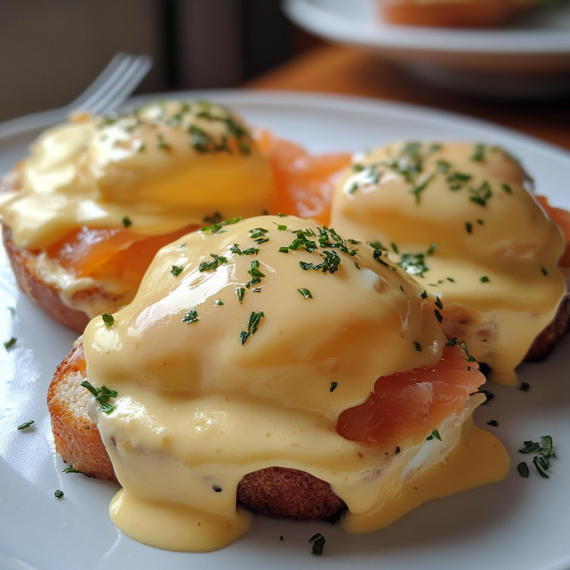Eggs Benedict is a rich and flavorful breakfast dish that’s perfect for any brunch occasion. With its perfectly poached eggs, decadent hollandaise sauce, and toasted English muffin, it’s no wonder this dish has become a brunch favorite. Whether you’re a beginner or a seasoned chef, Eggs Benedict offers a delicious challenge that’s sure to impress your guests. In this post, we’ll explore the history, key ingredients, and step-by-step instructions for making this luxurious dish at home. Get ready to elevate your brunch game with this mouthwatering recipe!
What is Eggs Benedict?
The Origins of Eggs Benedict
The origins of Eggs Benedict are widely debated. One popular story points to the late 19th century in New York City. According to this tale, a woman named Mrs. LeGrand Benedict asked a chef at Delmonico’s Restaurant to create a new dish for her. The result was poached eggs on English muffins, topped with hollandaise sauce and bacon.
Another theory suggests the dish was named after Lemuel Benedict, a New York stockbroker. He supposedly ordered a similar dish at the Waldorf Hotel in 1894. The chef liked the idea and added his own twist, creating the version we know today.
Though the true origin remains unclear, Eggs Benedict has become a beloved brunch classic. Its rich flavor and elegant presentation make it a favorite choice for special occasions.

Key Components of Eggs Benedict
Eggs Benedict is a dish made up of several key components that come together to create its rich flavor. The base is a toasted English muffin, which provides a slightly crisp texture. On top of the muffin, you’ll find crispy bacon or Canadian bacon, offering a savory contrast to the eggs.
The star of the dish is the poached egg, which should have a perfectly runny yolk. The eggs are carefully cooked so that the whites are set while the yolk remains soft. Finally, the dish is smothered in hollandaise sauce, a creamy, buttery sauce made with egg yolks, lemon juice, and melted butter.
These simple yet decadent components combine to make Eggs Benedict a luxurious dish that’s both comforting and indulgent. Each ingredient plays an important role in achieving the perfect balance of flavors and textures.
Classic vs. Modern Variations
Eggs Benedict has evolved over time, with many delicious variations added to the classic recipe. The traditional version features poached eggs, Canadian bacon, and hollandaise sauce on a toasted English muffin. It’s a rich and satisfying dish that remains a brunch favorite.
Modern variations often swap out the bacon for other ingredients. Smoked salmon, for example, makes a delicious twist and is known as “Eggs Royale.” For a vegetarian option, spinach or avocado can replace the meat, resulting in a lighter yet equally satisfying dish.
Some variations add unique elements like crab, lobster, or even fried chicken. The sauce may also be spiced up with ingredients like chipotle or Dijon mustard for a flavor boost. These modern versions keep the essence of Eggs Benedict while allowing for creative experimentation with flavors and textures.
Essential Ingredients for the Perfect Eggs Benedict
Poached Eggs
Poached eggs are the centerpiece of Eggs Benedict. The key to a perfect poached egg is timing. The whites should be fully set, while the yolk remains soft and runny. To achieve this, use fresh eggs, as they hold their shape better in water.
To poach eggs, bring a pot of water to a gentle simmer and add a splash of vinegar. The vinegar helps the egg whites stay together. Crack the egg into a small bowl, then gently slide it into the water. Cook for about 3-4 minutes, depending on your preference for yolk consistency.
Once done, carefully remove the egg with a slotted spoon. This technique ensures the egg remains intact and doesn’t become too watery. Perfectly poached eggs create that signature rich, runny yolk that adds flavor and texture to your Eggs Benedict.

Hollandaise Sauce
Hollandaise sauce is a creamy, buttery sauce that’s essential to the flavor of Eggs Benedict. It’s made from egg yolks, melted butter, and a touch of acid, typically lemon juice or vinegar. The sauce has a smooth texture and a rich, tangy taste that complements the poached eggs.
To make hollandaise, start by whisking egg yolks with lemon juice in a heatproof bowl. Place the bowl over a pot of simmering water, making sure the bowl doesn’t touch the water. Slowly drizzle in melted butter while whisking constantly until the sauce thickens.
The key to success is maintaining a low, steady heat. If the sauce gets too hot, the eggs can scramble. Adjust the seasoning with salt and a pinch of cayenne pepper for extra flavor. Hollandaise sauce should be served immediately, as it can lose its smooth texture over time.
English Muffin and Toppings
The English muffin is the perfect base for Eggs Benedict. Its light, slightly chewy texture provides a great contrast to the rich ingredients. The muffin should be split in half and toasted to a golden crisp, which helps it hold up against the sauce without becoming soggy.
For toppings, traditional Eggs Benedict uses Canadian bacon, but there are plenty of alternatives. A popular option is sautéed spinach, which adds a fresh, slightly earthy flavor. Another great choice is avocado, offering a creamy texture and subtle taste that balances the richness of the hollandaise sauce.
For a more decadent twist, you can add fresh crab or smoked salmon. These toppings bring extra layers of flavor while keeping the dish elegant. Regardless of your topping choice, the key is to ensure each element complements the other for a well-rounded and satisfying meal.
Step-by-Step Guide to Making Eggs Benedict
How to Poach Eggs Perfectly
Poaching eggs perfectly takes practice, but with a few simple steps, you can achieve excellent results. Start by filling a pot with water and bringing it to a gentle simmer, not a full boil. Add a splash of vinegar to the water; this helps the egg whites hold together.
Crack a fresh egg into a small bowl, avoiding any shell fragments. Stir the water gently to create a mild whirlpool. Carefully slide the egg into the center of the whirlpool. The swirling motion helps keep the egg together.
Let the egg cook for about 3-4 minutes for a soft, runny yolk. If you prefer a firmer yolk, leave it in for an additional minute. Once done, use a slotted spoon to gently lift the egg from the water. Let it drain, then serve immediately for the perfect poached egg on your Eggs Benedict.

Making the Perfect Hollandaise Sauce
Making the perfect hollandaise sauce requires attention to detail and patience. Start by whisking egg yolks and lemon juice in a heatproof bowl. Place the bowl over a pot of simmering water, ensuring the bowl doesn’t touch the water. This method creates gentle heat to cook the eggs without scrambling them.
Slowly add melted butter, a little at a time, while whisking constantly. The sauce should begin to thicken as you incorporate the butter. If the sauce gets too thick, add a teaspoon of warm water to loosen it up.
Season with salt and a pinch of cayenne pepper for added flavor. The key is to keep the heat low and whisk consistently. Once the sauce is smooth and creamy, remove it from the heat. Serve immediately, as hollandaise can break down or become too thick if left too long.
Assembling Eggs Benedict
Assembling Eggs Benedict is simple but requires careful attention to detail. Start by placing the toasted English muffin halves on a plate, cut side up. If using bacon or another topping, arrange it on each muffin half.
Next, gently place the perfectly poached egg on top of each muffin half. The egg should be warm, with the yolk slightly runny. This adds a rich and smooth texture to the dish.
Generously drizzle the freshly made hollandaise sauce over the poached egg. Be sure to cover the egg and the muffin well with the sauce, but don’t drown it.
Finish by garnishing with fresh herbs, such as chopped chives or parsley, for a pop of color. Serve immediately while the dish is warm and enjoy the combination of flavors and textures that make Eggs Benedict so indulgent and delicious.
Why Eggs Benedict is a Brunch Favorite
The Richness of the Dish
The richness of Eggs Benedict comes from its combination of flavors and textures. The creamy hollandaise sauce adds a luxurious, buttery taste that coats the poached eggs and muffin. The eggs themselves, with their soft, runny yolks, bring a delicate richness that balances the sauce’s heaviness.
The toasted English muffin provides a slight crunch, giving the dish a satisfying contrast to the soft, creamy elements. If you add toppings like smoked salmon, or spinach, they introduce additional layers of flavor, enhancing the overall richness.
Every bite of Eggs Benedict offers a mix of warm, creamy, and savory elements. The poached egg’s yolk combines with the hollandaise sauce, creating a velvety texture that coats each ingredient. This harmony of flavors and textures makes the dish indulgent, yet perfectly satisfying, especially when enjoyed during a leisurely brunch or special occasion.

Impressing Guests at Brunch
Eggs Benedict is an excellent way to impress guests at brunch. Its elegant presentation makes it look sophisticated, yet it’s simple to prepare. The combination of poached eggs, hollandaise sauce, and a perfectly toasted muffin always wows guests.
The richness of the dish feels luxurious, and the runny egg yolk adds a dramatic touch when cut into. Serve it on a beautiful plate, garnished with fresh herbs, and it will look like a professional chef made it.
If you want to elevate the dish even more, offer variations like smoked salmon or spinach. These add an extra layer of flavor and show that you’ve put thought into the meal. The best part? Despite its impressive appearance, Eggs Benedict can be made ahead of time, giving you more time to focus on enjoying your brunch with friends and family.
Pairing with Drinks
Pairing Eggs Benedict with the right drink can elevate the meal even further. For a refreshing contrast to the richness of the dish, try serving a glass of freshly squeezed orange juice. The bright, citrusy flavor balances the creamy hollandaise sauce and poached eggs beautifully.
A light, herbal iced tea is another excellent choice. Its refreshing taste and subtle flavors complement the dish without overpowering it. You can also opt for a cold brew coffee, which offers a smooth, slightly bitter contrast to the richness of Eggs Benedict.
For a more refined option, consider a cucumber or mint-infused water. The cool, crisp flavors refresh the palate between bites. Another great pairing is a fruit smoothie, made with berries or tropical fruits, adding a natural sweetness that works well with the savory flavors of the dish. These drinks make perfect companions for a delicious brunch experience.
Variations of Eggs Benedict to Try
Smoked Salmon Eggs Benedict
Smoked Salmon Benedict is a delicious twist on the classic recipe, adding a fresh and smoky flavor. Instead of traditional bacon or Canadian bacon, smoked salmon is used as the main protein. Its rich, slightly salty taste pairs beautifully with the creamy hollandaise sauce and soft poached eggs.
To make this variation, simply replace the bacon with a generous layer of smoked salmon on each toasted English muffin half. The rest of the recipe remains the same—poached eggs, hollandaise sauce, and any garnishes you choose. The smoky flavor of the salmon enhances the overall richness of the dish, creating a unique and luxurious version of Eggs Benedict.
This variation is perfect for those who prefer seafood or want to try something different. Smoked Salmon Benedict is a sophisticated yet easy-to-make dish that adds a touch of elegance to any brunch.

Vegetarian Eggs Benedict
Vegetarian Eggs Benedict is a fantastic option for those who prefer a meatless dish without sacrificing flavor. Instead of bacon or Canadian bacon, you can use fresh spinach, avocado, or even roasted tomatoes as the main topping. These ingredients add depth and richness to the dish while keeping it light and healthy.
To make this version, sauté spinach with garlic and a little olive oil for a savory base, or slice avocado for a creamy texture. Layer these on the toasted English muffin, then top with the poached egg and a generous drizzle of hollandaise sauce.
This variation is not only delicious but also versatile. You can experiment with other vegetables like sautéed mushrooms or grilled asparagus. Vegetarian Eggs Benedict offers a satisfying, plant-based twist on the traditional recipe, making it perfect for vegetarians or anyone looking to try something new.
Global Twists on Eggs Benedict
Global twists on Eggs Benedict bring exciting flavors from around the world to this classic dish. In Mexico, you can try “Huevos Benedictos,” where the hollandaise sauce is replaced with spicy salsa or a smoky chipotle sauce. The combination of heat and richness adds a unique twist to the traditional recipe.
In France, a variation known as “Eggs Monty” uses a béarnaise sauce instead of hollandaise. Béchamel sauce with tarragon gives the dish a fresh, herby flavor.
For a Mediterranean twist, swap the muffin for pita bread and use feta cheese along with spinach or olives. This version incorporates bold, tangy flavors that make it a delightful alternative.
These global variations show how versatile Eggs Benedict can be. Each new twist adds its own flavor profile, transforming the dish into a fusion of cultures and culinary traditions.
Conclusion
Eggs Benedict is a luxurious and versatile dish that never fails to impress. Whether you enjoy the classic version or experiment with variations like smoked salmon or vegetarian options, it’s sure to elevate any brunch.
The combination of poached eggs, hollandaise sauce, and toasted English muffin creates a perfect balance of flavors and textures. With countless ways to customize the dish, you can enjoy Eggs Benedict in many exciting ways. Try it for your next brunch, and watch your guests delight in this indulgent and satisfying meal.

